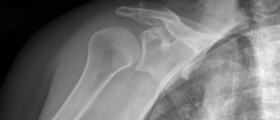
The clavicle, also known as the collar bone belongs to a group of long bones and it connects the sternum (breastbone) with the scapula (shoulder blade). In humans there is one clavicle on each side of the body. This bone keeps the shoulder joint away from the body and by doing so it allows greater range of movements in the particular joint. Furthermore, the clavicle protects the underlying nerves and blood vessels which are coming from the neck and enter the arms.
Clavicle fracture is considered frequent injury and is caused by injury or trauma. This bone fractures if one falls on his/her outstretched hand or in case a person lands on the shoulder. What is more, a fracture can be caused by a direct blow to the shoulder. A direct blow to the clavicle and subsequent fracture usually occurs in car accidents and it may also affect people engaged in certain contact sports such as football or wrestling.
Clavicle Fracture: Symptoms and Signs
The injured shoulder is painful, tender to touch and swollen. Depending on the severity of the injury the injured area may be bruised. One may even notice the presence of a bump. If the clavicle fracture is open, the bone fragments protrude through the skin and are easily noticed. The patients also complain about weakness of the arm muscles, numbness and tingling sensation. The person may be unable to move the injured arm.
How is Clavicle Fracture Diagnosed?
The easiest way to confirm clavicle fracture is to perform x-ray of the shoulder area. Apart from the x-ray there are two more imaging methods suitable for diagnosing this fracture and they include computerized tomography scan and magnetic resonance imaging scan.
Clavicle Fracture: Treatment
Treatment for clavicle fracture depends on the type of fracture and the associated damage. In majority of cases fracture heals spontaneously. It is essential for people who have experienced clavicle fracture to have plenty of rest. Initially, the arm is not supposed to be moved. The pain caused by the fracture is alleviated with pain killers and some patients may require antibiotics as well. Further damage of the surrounding tissues by bone fragments is successfully prevented with splints or slings. Supportive therapy includes ice packs and one should engage in physical therapy once swelling and pain have subsided. Physical therapy restores all the movements in the shoulder joint and strengthens the muscles of the shoulder area. In severe fracture the person undergoes surgical repair. The bone fragments are returned to their original place and connected with pins, plates and/ or screws. Surgery is also treatment modality for patients who have suffered damage of nearby nerves and blood vessels.










-Causes,-Symptoms,-Diagnosis,-Treatment_f_280x120.jpg)






Your thoughts on this
Loading...